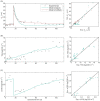Optimising the Flux Enhancer Dosing Strategy in a Pilot-Scale Anaerobic Membrane Bioreactor by Mathematical Modelling
- PMID: 35207073
- PMCID: PMC8877340
- DOI: 10.3390/membranes12020151
Optimising the Flux Enhancer Dosing Strategy in a Pilot-Scale Anaerobic Membrane Bioreactor by Mathematical Modelling
Abstract
Flux enhancers (FEs) have been successfully applied for fouling mitigation in membrane bioreactors. However, more research is needed to compare and optimise different dosing strategies to improve the filtration performance, while minimising the use of FEs and preventing overdosing. Therefore, the goal of this research is to develop an optimised control strategy for FE dosing into an AnMBR by developing a comprehensive integrated mathematical model. The integrated model includes filtration, flocculation, and biochemical processes to predict the effect of FE dosing on sludge filterability and membrane fouling rate in an AnMBR. The biochemical model was based on an ADM1, modified to include FEs and colloidal material. We developed an empirical model for the FE-induced flocculation of colloidal material. Various alternate filtration models from the literature and our own empirical models were implemented, calibrated, and validated; the best alternatives were selected based on model accuracy and capacity of the model to predict the effect of varying sludge characteristics on the corresponding output, that is fouling rate or sludge filterability. The results showed that fouling rate and sludge filterability were satisfactorily predicted by the selected filtration models. The best integrated model was successfully applied in the simulation environment to compare three feedback and two feedforward control tools to manipulate FE dosing to an AnMBR. The modelling results revealed that the most appropriate control tool was a feedback sludge filterability controller that dosed FEs continuously, referred to as ∆R20_10. Compared to the other control tools, application of the ∆R20_10 controller resulted in a more stable sludge filterability and steady fouling rate, when the AnMBR was subject to specific disturbances. The simulation environment developed in this research was shown to be a useful tool to test strategies for dosing flux enhancer into AnMBRs.
Keywords: anaerobic membrane bioreactor (AnMBR); control tool; flux enhancer; integrated model; sludge filterability.
Conflict of interest statement
The authors declare no conflict of interest.
Figures






References
-
- van Lier J.B., Mahmoud N., Zeeman G. Anaerobic Wastewater Treatment. In: van Loosdrecht M.C.M., Ekama G.A., Brdjanovic D., editors. Biological Wastewater Treatment, Principles, Modelling and Design. 2nd ed. IWA Publishing; London, UK: 2020.
-
- Robles A., Ruano M.V., Charfi A., Lesage G., Heran M., Harmand J., Seco A., Steyer J.-P., Batstone D.J., Kim J., et al. A review on anaerobic membrane bioreactors (AnMBRs) focused on modelling and control aspects. Bioresour. Technol. 2018;270:612–626. doi: 10.1016/j.biortech.2018.09.049. - DOI - PubMed
-
- Yoon S., Collins J.H. A novel flux enhancing method for membrane bioreactor (MBR) process using polymer. Desalination. 2006;191:52–61. doi: 10.1016/j.desal.2005.04.124. - DOI
-
- Iversen V., Mehrez R., Horng R.Y., Chen C.H., Meng F., Drews A., Lesjean B., Ernst M., Jekel M., Kraume M. Fouling mitigation through flocculants and adsorbents addition in membrane bioreactors: Comparing lab and pilot studies. J. Memb. Sci. 2009;345:21–30. doi: 10.1016/j.memsci.2009.08.014. - DOI
Grants and funding
LinkOut - more resources
Full Text Sources
Miscellaneous

